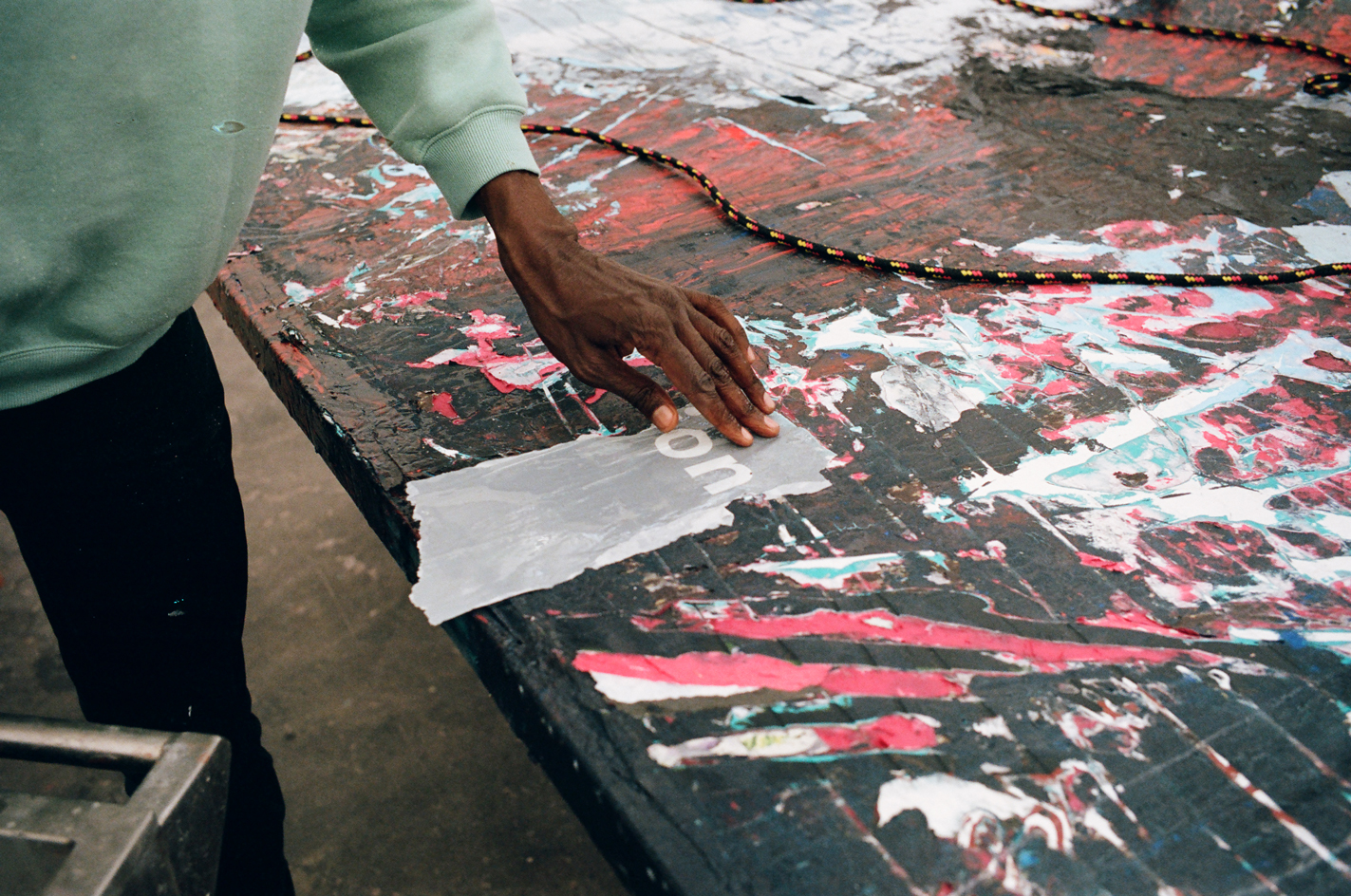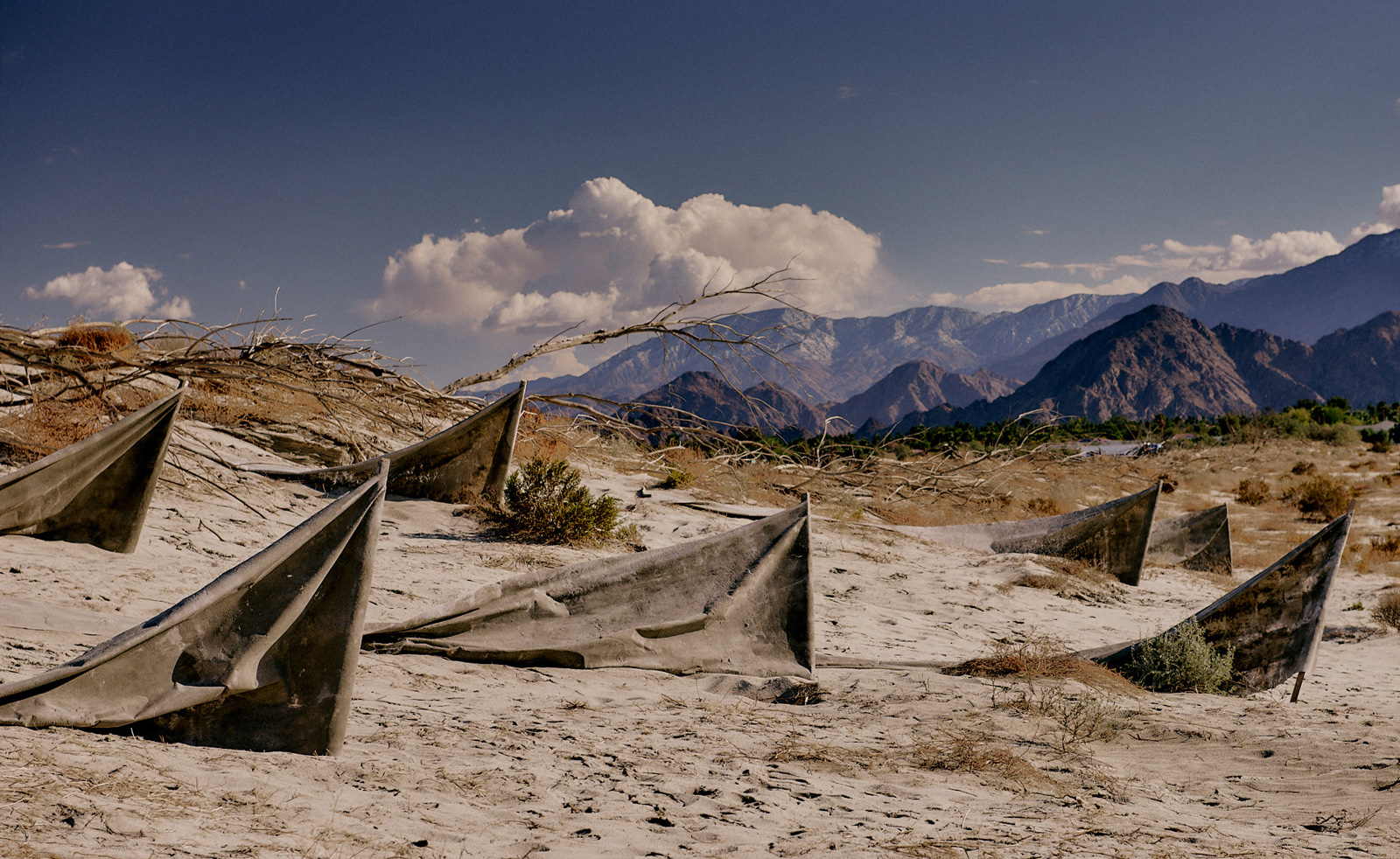Mark Bradford’s epic show puts Hauser & Wirth Menorca on the map
We visited American artist Mark Bradford at his studio, ahead of his major solo show ‘Masses and Movements’, which inaugurated Hauser & Wirth’s new Menorca arts centre in July 2021

Max Farago - Photography
Mark Bradford excavates the past through art. And the past has never felt more present than in 2020, during the global pandemic. Substantial and sumptuous, his abstract paintings have received such acclaim that, Bradford, now 59, has grown accustomed to the demands of being an international art star with a roster of museum and gallery shows.
Winner of a 2009 MacArthur ‘genius’ grant and US representative to the 2017 Venice Biennale, he was elected recently to the elite American Academy of Arts and Letters. His retrospective ‘End Papers’ opened last year at Texas’ Modern Art Museum of Fort Worth, as the spread of Covid-19 led to one lockdown after another. ‘A year ago,’ he recalls, ‘I was like, well, one thing I know how to do is to show up and go to work. So I’m gonna show up, I’m gonna go to work. I’m gonna work with no assistants, one assistant, a few supplies, a lot of supplies, because that was changing by the week.’

Works in progress in the artist’s 50,000 sq ft Los Angeles studio
Forced by travel restrictions and common sense to stay home in Los Angeles, he passed time and explored history by looking at the 1507 Waldseemüller map of the world. Visitors to his Los Angeles studio have been scarce and he is eager to talk about it. Dressed in white sweatshirt and trousers, he has the grace of a very tall dancer as he lopes over to give me an air-hug. Bending himself into a folding chair at a card table, Bradford explains his latest inspiration: ‘I’ve always been fascinated by ancient maps. They become maps of the imagination because obviously maps continually change with wars, with land redistributions, with ecology.’
The Waldseemüller map is a saga of its own and it’s easy to see the attraction for an artist. Not only is it the first record of the word ‘America’, recognising the claim by Florentine explorer Amerigo Vespucci to have ‘discovered’ the continent now known as South America, but the map itself is also a work of art. The four-sheet woodblock print, roughly 4ft x 8ft was created in Strasbourg by cartographer Martin Waldseemüller and Matthias Ringmann, a scholar of Ptolemy’s studies of latitude and longitude. The map was the first to show the continent as surrounded by ocean, not as an extension of Asia. It is long and skinny, with a closer resemblance to Argentina, but it established a landmass that extends south of the equator. ‘The way in which we even obtain this idea of America on the map was a leap of faith,’ says Bradford. ‘It was such a chance, a decision made by listening to other cartographers who had been in the region. I thought that was super interesting because it was the artist’s imagination.’ His comment recalls Ralph Ellison’s narrator in The Invisible Man looking at a map and wondering how Columbus could have thought it was India, as he tries to understand his own place in a shifting world.

Mark Bradford’s The Price of Disaster, 2021, mixed media on canvas, 213cm x 274cm, features sweeping movements of gestural abstraction in various colours swirling around an undefined point near the centre of the canvas. The work features on the limited-edition cover of Wallpaper's July 2021 issue. Limited-edition covers are available to subscribers
Bradford’s paintings, larger than mere wall maps, vibrate with criss-crossed gestures that simulate the energy and urgency of global matters. ‘With everything that I was experiencing and especially with the protests and the much-needed conversations around race in this country, I chose a map that said for the first time, “America”. What does the word America mean for an African American? It is all there,’ Bradford says. The title for his new show: ‘Masses and Movements’.
It’s hard to conceive of a more fitting location for the debut of these works than Hauser & Wirth’s new outpost on Isla del Rey in the port of Mahón in Menorca, set to open in July 2021. One of the Balearic Islands off the coast of Spain, Menorca’s enviable position and port have attracted Phoenician, Roman, Ottoman, Spanish and British occupations over the centuries, each leaving behind evidence in its wake.
What does the word America mean for an African American?
One example is the decommissioned naval hospital built by the British in the 18th century that is being restored by Hauser & Wirth and Argentine architect Luis Laplace, who designed its Somerset arts centre and St Moritz gallery. A series of eight gallery spaces, a shop and a restaurant will nestle in gardens by Piet Oudolf that overlook the sea.
The gallery’s co-founders Iwan and Manuela Wirth were, says Iwan, ‘utterly captivated by Menorca and specifically Isla del Rey, which is spectacular. Our vision has always been to expand the idea of the gallery experience and we believe that this location is a fitting, natural and exciting extension to our centres in Somerset and LA. Given the setting so steeped in history and Mark Bradford’s interest in the legacy of the past on contemporary society, he was our choice to inaugurate the new location.’

Sugar Factory (detail), 2021
Coincidentally, these latest paintings are an excavation of Bradford’s personal past. They were not made specifically for the site but were influenced by summers spent on the neighbouring island of Mallorca when he was in his twenties. He hadn’t yet found his way to college, and was helping his mother by working in her beauty salon. Two of her clients had bought houses in Mallorca and invited him to visit. When he asked, ‘How am I going to find you in this town?’ They said, ‘Oh, just ask for the Black women.’
Using gesso, paint and stone, he helped them renovate the old structures. That process of building – whether making an elaborate hairstyle in his mother’s salon or erecting a wall – became integral to the way Bradford learned to make his work in layers. In this case, the neutral palette reflects the tans and taupes of the island landscape with an occasional flash of blue, green or yellow.
I was fascinated by these little wind symbols on the Waldseemüller map. For me, it’s almost like they blew my people north, west, south and east
Superficially expressive and abstract, each work in the new show derives its organising principle from actual maps, with special nautical rope delineating order and structure. Papers and printed matter are glued down only to be sanded or torn off or obscured. Using caulk, Bradford adds the curved latitudinal and longitudinal lines of a globe. Thick textures cover the surfaces but allow glimpses of imagery drawn from the Waldseemüller map, such as the zephyrs that symbolise directions and wind patterns, as well as the occasional word.
‘I was fascinated by these little wind symbols on the map. For me, it’s almost like they blew my people north, west, south and east,’ says Bradford. ‘We go from Africa, all the way to the Caribbean, all the way east, all the way through Europe, all the way through the Americas. It was forced but many of us got to where we were, outside of our homelands, on the winds in the sails that pushed those boats. I kept looking at those things thinking, “Yeah, they blew us all over the world.”’


Top and above: Mark Bradford working on a painting in his studio, 2021
The show also includes sculptures of globes in a single line, in progressively smaller circumferences. ‘This idea of the pandemic, it was not equitable. That’s why there are some big Earths and little Earths. It is a global thing we experienced but we are all not experiencing it the same way.’
Bradford regularly borrows from Greek and Roman mythology, as a way of presenting afresh the stories of gods and goddesses, heroes and villains, with all their foibles and powers. His 2019 show at Hauser & Wirth London, was titled ‘Cerberus’ after the three-headed dog preventing the dead from leaving Hades. Sculptures referencing Medusa have explosive serpentine hair, in a nod to the artist’s collection of comic books and their characters, often drawn from mythology. Old comics have also been repurposed as the bases of his latest paintings, offering tantalising fragments of stories never to be finished.
He believes the isolation of the past year contributed to an interior journey in the studio. Working mostly alone, Bradford felt his work changing. Despite the orderly grid that has underpinned his art from the outset, he embraced a more fluid approach. ‘I think this body of work is me allowing the grids, but also allowing the slippage and the spontaneity, and actually, nature,’ he says. ‘Not just demanding that the only thing I know is the urban environment.’
Wallpaper* Newsletter
Receive our daily digest of inspiration, escapism and design stories from around the world direct to your inbox.

Mark Bradford's studio, 2021
With one of his deep self-deprecating laughs, Bradford adds, ‘If you’re going to tell me to close down, I’m probably going to do just the opposite. Open up, which means taking more risk in the work, finding a way to do it.’
Bradford has faith in the utility of the workaround, which was essential to his survival as a 6ft 8in tall, gay, Black adolescent in South Central LA. After discovering club life, he started flunking classes in high school. He didn’t attend college until he was in his late twenties, when he won a scholarship to CalArts. He received his Master of Fine Arts in 1997; he was then 36. The curriculum was heavily influenced by conceptual art, which helped Bradford uncover who he did and did not want to be. In 2001, his collages using curling papers from his mother’s beauty salon featured in Thelma Golden’s ground-breaking ‘post-Black’ ‘Freestyle’ exhibition at Harlem’s Studio Museum. In time, he incorporated grids provided by maps of LA, along with posters and advertisements. The grid referred to modernist art and provided order for his jazzy impromptu surfaces. The originality came in his use of collage and décollage.

Two of Mark Bradford’s mixed media works on canvas: left, The Bottom of the Revolution, 2021; right, Forgotten Statue, 2021
Collage is a historically significant aspect of contemporary art in LA, especially among Black artists ranging from Noah Purifoy to Betye Saar. Bradford had grafted two genres, collage and abstract expressionist painting, into a powerful new species. Success came swiftly, with collector Eli Broad buying works from his early gallery shows. (The collector’s namesake museum, The Broad, now has 11.)
Bradford demonstrates allegiance to his origins with his foundation, Art + Practice, located in the historically Black neighbourhood of Leimert Park since 2014. Established with his partner Allan DiCastro and collector Eileen Harris Norton, it hosts exhibitions of contemporary art along with a crucial, innovative programme of support for foster youth. This evolved out of Bradford’s own wayward youth, as someone who almost fell through the cracks in the absence of education and opportunity. Recognising his good fortune, he chooses to pay it forward but rejects the label of ‘activist’.
‘I’m an artist,’ he insists. ‘I think that the society or the mainstream or whatever you wanna call it, they just have a very limited idea of what an artist is capable of. So you find a way to survive that’s gonna keep you on safe ground,’ he says. ‘Doesn’t mean that you’re not angry sometimes. It doesn’t mean that you don’t feel. But you have to find that space in order to be able to move through the world, to keep moving in spite of. Not just keep moving, keep moving in spite of.’

Bradford with his work The Price of Disaster, in progress, which featured on the artist's July 2021 limited-editon Wallpaper* cover
A version of this article was originally featured in the July 2021 issue of Wallpaper* (W*267), available for free download
INFORMATION
‘Mark Bradford: Masses and Movements’, 19 July – 31 October 2021, Hauser & Wirth Menorca, hauserwirth.com
-
 Australian bathhouse ‘About Time’ bridges softness and brutalism
Australian bathhouse ‘About Time’ bridges softness and brutalism‘About Time’, an Australian bathhouse designed by Goss Studio, balances brutalist architecture and the softness of natural patina in a Japanese-inspired wellness hub
By Ellie Stathaki
-
 Marylebone restaurant Nina turns up the volume on Italian dining
Marylebone restaurant Nina turns up the volume on Italian diningAt Nina, don’t expect a view of the Amalfi Coast. Do expect pasta, leopard print and industrial chic
By Sofia de la Cruz
-
 Tour the wonderful homes of ‘Casa Mexicana’, an ode to residential architecture in Mexico
Tour the wonderful homes of ‘Casa Mexicana’, an ode to residential architecture in Mexico‘Casa Mexicana’ is a new book celebrating the country’s residential architecture, highlighting its influence across the world
By Ellie Stathaki
-
 Leonard Baby's paintings reflect on his fundamentalist upbringing, a decade after he left the church
Leonard Baby's paintings reflect on his fundamentalist upbringing, a decade after he left the churchThe American artist considers depression and the suppressed queerness of his childhood in a series of intensely personal paintings, on show at Half Gallery, New York
By Orla Brennan
-
 Desert X 2025 review: a new American dream grows in the Coachella Valley
Desert X 2025 review: a new American dream grows in the Coachella ValleyWill Jennings reports from the epic California art festival. Here are the highlights
By Will Jennings
-
 In ‘The Last Showgirl’, nostalgia is a drug like any other
In ‘The Last Showgirl’, nostalgia is a drug like any otherGia Coppola takes us to Las Vegas after the party has ended in new film starring Pamela Anderson, The Last Showgirl
By Billie Walker
-
 ‘American Photography’: centuries-spanning show reveals timely truths
‘American Photography’: centuries-spanning show reveals timely truthsAt the Rijksmuseum in Amsterdam, Europe’s first major survey of American photography reveals the contradictions and complexities that have long defined this world superpower
By Daisy Woodward
-
 Sundance Film Festival 2025: The films we can't wait to watch
Sundance Film Festival 2025: The films we can't wait to watchSundance Film Festival, which runs 23 January - 2 February, has long been considered a hub of cinematic innovation. These are the ones to watch from this year’s premieres
By Stefania Sarrubba
-
 What is RedNote? Inside the social media app drawing American users ahead of the US TikTok ban
What is RedNote? Inside the social media app drawing American users ahead of the US TikTok banDownloads of the Chinese-owned platform have spiked as US users look for an alternative to TikTok, which faces a ban on national security grounds. What is Rednote, and what are the implications of its ascent?
By Anna Solomon
-
 Architecture and the new world: The Brutalist reframes the American dream
Architecture and the new world: The Brutalist reframes the American dreamBrady Corbet’s third feature film, The Brutalist, demonstrates how violence is a building block for ideology
By Billie Walker
-
 Inside the distorted world of artist George Rouy
Inside the distorted world of artist George RouyFrequently drawing comparisons with Francis Bacon, painter George Rouy is gaining peer points for his use of classic techniques to distort the human form
By Hannah Silver